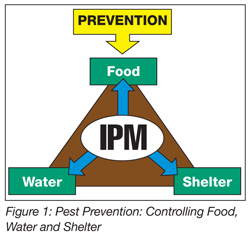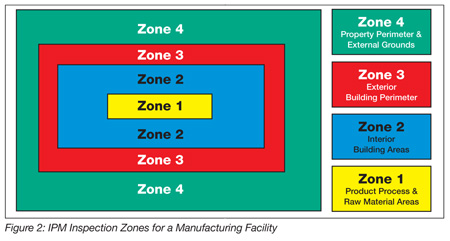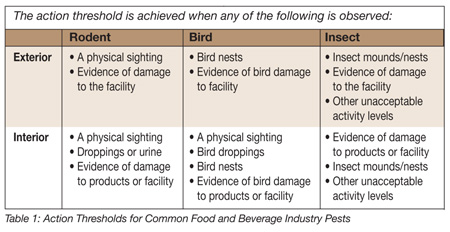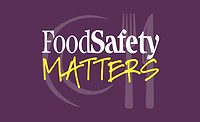It has been estimated that more than 40% of the world’s food production is lost because crops are destroyed by pests and diseases. Once harvested, an additional 20% may be lost during storage and transport. Aside from the economic loss they can cause, pests are a known vector for disease, may contaminate products and cause structural damage to facilities. Clearly, everything possible should be done to reduce further loss due to pests within the confines of the manufacturing environment.
Traditional pest control programs rely on monitoring and reactive control mechanisms such as responding to the visual evidence of pests with tactics including the application of insecticides, rodenticides or the use of traps and discursion devices. These tactics may be ineffective without a fundamental understanding of the biological and physical requirements of pests and of their vulnerability, which is the cornerstone of an integrated pest management (IPM) approach.
IPM can be described as “a coordinated decision-making and action process that uses the most appropriate pest control methods and strategy in an environmentally and economically sound manner to meet programmatic pest management objectives.”
IPM is based on the 1950s concept of “integrated control,” which identified the most efficient mix of chemical and biological controls for a given insect pest in a manner that was least disruptive and most environmentally compatible. IPM took this concept one step further and leveraged “integrated control” for all types of pests, including those beyond chemical and biological control. By 1972, IPM found its way into the U.S. national policy, where concepts and applications were further advanced.
IPM concepts focus on four key elements and eight underlying strategies.
IPM Elements
Inspection - Inspect external and internal vulnerable areas for pest infestation and document findings.
Define Action Threshold - The point at which pest populations or environmental conditions indicate that pest control action must be taken.
Control and Evaluate - When monitoring, identification and action thresholds indicate that control is required, select the appropriate control tactics, take action and evaluate the effectiveness of the action plan.
Education - Ensure continued success of the IPM program by educating those involved with administering the program and establishing documentation to support the program.
IPM Strategies
Inspect - Inspect external and internal areas for pest infestation, focusing on areas of vulnerability.
Identify - Correct identification of the target pest is a critical step in the control process, enabling pests to be eliminated more efficiently.
Monitor - As pest control is an ongoing process, constantly monitoring your facility for pest activity and instituting operational changes that affect pest management will protect against infestation and help eliminate existing pests.
Determine If and When Control Is Needed - Control is necessary when the threshold for pest infestation has been exceeded.
Understand Options and Develop an Action Plan - Understand all options that are available for control. Evaluate both the benefits and risks for each option prior to developing the action plan.
Take Action - Appropriate actions should be taken to eliminate an existing pest infestation. Those actions should also prevent future infestations from occurring by focusing on non-chemical options first.
Evaluate Results - The pest control program must include a thorough evaluation of how effective the treatment methods were in eliminating the pest infestation. Depending on the success of the methods used, treatment strategies may need to be adjusted.
Education - To ensure continued success of the pest control program, all personnel involved in administering the program as well as general personnel should be educated on the strategies used.
The practical application of IPM can be managed by the following prerequisites and a logic sequence.
IPM Prerequisites
Select the IPM Team
The food processor should assure that the appropriate knowledge and expertise is available for the development and continuing success of IPM. Select and assemble a team of individuals who have specific technical and practical knowledge of pests, their vulnerabilities and application of effective control measures.
It is critical that the IPM team is established and led by a pest management specialist. Team members should be chosen to represent critical sectors of the facility’s operations that would be impacted by the IPM program. Consideration should be taken to include representatives from third-party pest management contractors. Pest control operators (PCO), both internal and external to the facility, should be trained and certified in chemical applications.
The IPM team is responsible for creating an IPM plan on an annual basis and managing supporting documents. An effective annual plan would require the team to conduct a risk analysis of the interior and exterior locations, develop action plans and establish action thresholds to address the risks and perform periodic reviews of the plan to ensure it is up-to-date and effective.
In addition, the team also conducts ongoing pest inspections of the facility, oversees third-party contractor approval and performance and ensures effective training for general personnel.
Prevention
 Prior to implementing IPM, the team should have fundamental knowledge of IPM prerequisites. Preventive action addresses vulnerabilities identified before pest problems occur and focuses on controlling and eliminating potential sources of food, water and shelter within interior and exterior areas of the facility (Figure 1). Cleaning and sanitation programs for the facility’s equipment, building and grounds are critical to the success of IPM.
Prior to implementing IPM, the team should have fundamental knowledge of IPM prerequisites. Preventive action addresses vulnerabilities identified before pest problems occur and focuses on controlling and eliminating potential sources of food, water and shelter within interior and exterior areas of the facility (Figure 1). Cleaning and sanitation programs for the facility’s equipment, building and grounds are critical to the success of IPM.
Controlling Food and Water Sources
Pests require an available food or water source to thrive. It is critical that food and water sources are controlled or eliminated where possible. Unnecessary water sources, such as standing water and puddles, should be prevented by maintaining proper drainage and sloping of facility grounds. Within the facility, plumbing leaks and other sources of free moisture should be eliminated.
Dumpsters and trash containers should be controlled with limited access, kept away from doorways and have tight-fitting lids and liners to prevent spillage. Waste must not be allowed to accumulate and should be removed regularly. Within the facility, all areas should be kept clean by conducting sufficient cleaning and sanitizing protocols and ensuring compliance with Good Manufacturing Practices (GMPs).
Controlling Shelter
Controlling and eliminating pest shelter sites is an effective way of reducing pest pressure on the facility by removing nearby harbourage sites and eliminating breeding grounds.
Keeping the exterior landscape properly maintained will prevent pests from migrating toward the facility. Overgrown brush near the facility should be removed to eliminate shelter and nesting areas. Ensure that landscaping is trimmed away from buildings and structures to at least 1 m. Appropriate spacing should also be maintained between items that are stored on the external grounds. Pallets, equipment and supplies should be at least 1 m from exterior walls and fences. Minimize the accumulation of trash, stacks of boards or other materials that can provide shelter for pests and when possible, inspect equipment and supplies for pests before bringing them onto the property.
Exclusion
Eliminating potential entry points for pests—including doors, windows, fan vents, air grilles and hoist apertures—is a simple but highly effective way of keeping pests out of the facility. All doors and windows should fit well and be kept closed when not in use. Metal sheeting should be used to eliminate gaps at junctions of walls, doors, floors and ceilings. Small openings can be filled with stainless steel wire pads or chicken wire embedded in cement. Gaps under doors may be filled with specially fitted nylon bristle strips. No gaps should be greater than 6 mm to exclude rodents and birds.
Any open access to the interior of the facility should be limited. Windows that open should be fitted with insect screens of appropriate mesh size to exclude flies but permit adequate ventilation. Large openings can be fitted with plastic strip-curtain doors that allow forklifts to pass through but deter rodents, birds and insects. The use of automatic doors can limit the amount of time these areas are open to the outside.
Inadequate building maintenance or poor building design can also lead to infestations. Cracks in walls, floors and other areas where pests can enter need to be filled. Items should be stored off the floor on pallets, slip-sheets or racks, maintaining a 0.5-m unobstructed, open-floor area around items. Quick fixes such as capping equipment, inlet piping and keeping drain covers and screens/traps for vents in place also help to eliminate simple shelters for pests. Most importantly, proper housekeeping and sanitation protocols should be followed.
Zoning
To facilitate appropriate and efficient pest inspections, a facility should be segregated into four separate inspection zones (Figure 2).

Defining specific inspection zones enables the IPM team to focus on key areas of the facility that require ongoing inspections. Each inspection zone will have unique vulnerabilities to pest infestation that need to be addressed. A detailed pest inspection checklist for each inspection zone should be developed to ensure effective inspections. The checklist should clearly identify every section of the premises within the inspection zones, points that need to be inspected, immediate and longer-term corrective actions and pest elimination strategies. All areas of infestation at the time of the inspection should be noted on the checklist.
IPM Application Sequence
Inspections of the IPM inspection zones should be carried out using a detailed pest inspection checklist. If an outside pest service is used, the inspection can be conducted jointly with the pest control contractor. Regular frequencies should be defined for both routine and periodic facility inspections. The inspections should identify structural defects, sanitation issues or any other conditions promoting pest infestation. The inspections must cover the entire site including grounds, buildings and other structures.
The purpose of the facility inspection is to:
• Identify, report and record any evidence of pests
• Examine and service all pest bait stations and monitoring devices on a periodic basis (remove droppings contained therein; remove any partially eaten bait and replace with clean bait)
• Draw attention to any aspect of exclusion or hygiene that could lead to potential pest problems
Inspections of external and internal areas must focus on locations that provide excess moisture, food sources, shelter and entry points that pests need to thrive. External inspections should focus on historic infestation problem areas at the facility and areas that are conducive to infestation. Internal inspections should focus on key areas within the facility that promote pest infestations as well as maintenance issues.
The scope of the IPM program will be based on the findings during the facility inspections that will help to determine the control tactics necessary for the pest causing the infestation.
Correctly identifying the target pest is essential to control; it enables pests to be eliminated more effectively and efficiently. Specific pest control tactics should be based on a thorough understanding of the pest’s biology and behavior, thus limiting its ability to survive. For example, distinguishing between a mouse and a rat will help to determine the best method of control. The following lists common pests that represent a high percentage of pest situations in the food and beverage industry:
• Rodent identification: house mouse, Norway rat and roof rat.
• Bird identification: European starling, English sparrow and pigeon/rock dove.
• Insect identification: house fly, fruit fly, stored-product insects (e.g., beetles and moths), ants and cockroaches.
A pest action threshold is the point at which pest populations or environmental conditions indicate that pest control action must be taken. The action threshold includes constant monitoring for pests and determining if and when control is needed. Thresholds for the four inspection zones will be increasingly stringent as more pest-sensitive areas are addressed.
Continuous monitoring of the facility for pest activity and operational changes that affect pest management will help to protect against infestation and eliminate existing pests. Identifying the signs and symptoms of infestation is critical to successful monitoring and can enable detection of activity before a visual confirmation is made.
For rodents, gnawing and teeth marks are common indicators of activity. Rodent droppings are often found with gnawed materials and can be confused with other droppings, including those of cockroaches and lizards. Proper identification of droppings will assist in accurate identification and monitoring activities. For example, all rodent droppings contain hair, but Norway rat droppings have blunt edges and roof rat droppings have pointed ends. Other signs of rodent infestation include burrows, digging and rub marks. As part of ongoing monitoring for exterior rodent activity, bait stations (with non-toxic baits), glue traps and other devices should be opened and inspected on a set schedule.
Due to the nature of bird infestations, monitoring for birds is a manual task. Some signs and symptoms that may indicate bird infestation include nests outside the facility, evidence of bird damage to the facility, and bird droppings at potential entrance and exit areas and at potential feeding and watering areas. Further evidence of bird infestation includes nesting materials in rafters and in corners of the warehouse, evidence of bird damage to products, or droppings on products.
Monitoring for insect activity requires multiple approaches. Look for insect trails, colonies and nesting sites such as potted plants, under slabs or in wall voids. Outdoor nesting sites may be under stones, boards, and similar objects near the facility. Regularly monitor insect control devices such as glue boards or fly lights for evidence of an increase or decrease in types and numbers of insects. Monitoring with insect phero-mones is a cost-effective tool that can provide early detection. Pheromone traps should be placed on a map or grid to identify areas of infestation.
 Control is necessary when signs of infestation have exceeded a pre-determined limit known as the “action threshold.” Action thresholds are pest-specific and must take into account both internal and external pest infestation. Some examples of observations indicating that an action threshold has been achieved for common food and beverage industry pests are listed in Table 1.
Control is necessary when signs of infestation have exceeded a pre-determined limit known as the “action threshold.” Action thresholds are pest-specific and must take into account both internal and external pest infestation. Some examples of observations indicating that an action threshold has been achieved for common food and beverage industry pests are listed in Table 1.
It is important to control and evaluate a pest situation when monitoring, identification and action thresholds indicate that pest control is required, is no longer effective or not available and preventative methods should be implemented. A sequence of events needs to take place to ensure effective control. These include understanding the control options available, developing an action plan, executing the plan and evaluating the results for effectiveness.
In most cases, there is more than one option available to control a pest infestation. It is important to understand all of the options that are available, with a focus on targeting the vulnerability of pests to keep them from returning. One must consider both the benefits of cost and the effects on the environment to ensure the appropriate use of control measures for the appropriate targets. Controlling pest infestations can be achieved by using the following three principles:
1. Reduce pest pressure of harboring and feeding outside the facility
2. Prevent pests from entering the plant
3. Eliminate interior conditions that enable pests to thrive
Controlling Rodents
Identifying and eliminating features around the exterior of the facility’s structures that are conducive to rodent harboring and feeding will help to reduce rodent pressure on the facility. This may include removing loose food materials from facility grounds, organic mulch products that border the building and unnecessary water sources from the facility grounds.
Rodent exclusion is the process of prohibiting rodents from entering a facility or structure. Since rodents can fit through relatively small cracks and crevices (6-mm diameter for mice and 12-mm diameter for rats), this can be a challenging task. Exclusion can be achieved by maintaining closed doors at all times, rebuilding walls or fixing structural issues in walls, filling gaps between door thresholds and doors and using construction materials that are not conducive to rodent chewing or gnawing such as metal, copper mesh or cement.
Baiting and trapping are common and practical ways to reduce rodent pressure. Rodenticides that are approved and regulated can be effective in reducing pest populations when used in a controlled manner. However, they should not be used directly outside the facility walls. Trapping devices can be used along the building’s exterior areas and on the exterior perimeter of the facility grounds to monitor for rodent activity and for reducing rodent pressure. These devices may include non-toxic baits, multiple catch traps or other mechanical trapping devices and should meet tamper-resistant standards, be weatherproof and anchored in place.
Maintaining proper interior conditions helps to minimize the rodents’ ability to thrive within the facility. This can be achieved by utilizing GMPs such as cleaning food material spills immediately, removing potential water sources, removing packaging or other material stored on the warehouse floor and updating facilities made out of rodent-friendly materials (sheetrock and insulation).
Controlling Birds
Removing or modifying a bird’s habitat and food supply is an important step in minimizing bird activity. Activities for reducing bird pressure on the facility include removing or properly pruning trees, replacing fruit trees with non-fruit trees, removing or eliminating nesting materials and nests, as well as trapping and relocating local bird populations as appropriate and legal.
Bird exclusion options to be considered may include the installation of automatic closing doors for exterior openings, bird spikes on potential perching sites, exclusion netting for preventing birds from entering an area, bird scare devices and electric shock tracks for keeping birds from resting on perches, ledges or signs. Other tactics may include modifying bird resting sites by installing covers or ramps, coiled wire, “porcupine wire” and repellent gels.
Interior conditions are the most difficult to modify to discourage bird activity as birds can adapt quickly to most situations. Excluding birds from potential harborage, nesting sites and ledges decreases a bird’s ability to thrive. In addition, removing any potential bird food material, water sources and nesting materials, as well as use of bird netting to prevent access to open areas will help keep birds from thriving inside the facility. The removal of birds from inside the facility should follow local regulatory standards. Mist nets and pre-baited trapping systems can be used to capture and relocate birds.
Controlling Insects
Reducing insect pressure can be accomplished by identifying and eliminating features on the facility grounds that are conducive to insects harboring and feeding, and through sanitation and GMP practices. Specific actions include cleaning garbage receptacles, keeping receptacles closed when not in use, scheduling garbage removal at least twice per week to break insect breeding cycles, eliminating excess food and water sources and removing vegetation near building foundations.
Insect exclusion prevents entry into a facility or structure. Exclusion tactics for insects include making all doors and windows tight-fitting with no potential entry gaps, installing self-closing warehouse or entrance doors, installing screens where appropriate (including windows, doors, and vents), installing air curtains, air doors or plastic strips on facility or dock doors, and caulking cracks and crevices around foundations.
Facility conditions are a key factor in preventing insect infestations. It is important to eliminate unsanitary conditions by removing food and water sources. Keep garbage and trash in containers with tight-fitting lids; remove trash and other items that provide hiding places; dry stagnant water or wet areas; check under slabs for broken water or sewer pipes; and eliminate plumbing leaks. In addition, vacuum all cracks and crevices to remove debris and food.
When there is evidence that a pest infestation has exceeded the established action threshold, immediate action must be taken to control the situation. By understanding options for reducing pest pressure outside the facility, preventing pests from entering the facility and eliminating conducive interior conditions, the facility will be able to develop an effective control plan. The actions taken should control the pest infestation to the point that there is clear evidence that the infestation is below the action threshold.
Chemical control methods should be considered the last control option in IPM and may not be needed if non-chemical control tactics are executed effectively. Pesticides are toxic chemicals designed to kill or prevent growth or breeding of pests. They are regulated federally and locally and should be used only by licensed and trained individuals, or under the supervision of a licensed individual (where allowed by law).
The IPM team as well as general personnel who have undergone pest control training should regularly monitor the facility and its surrounding areas for evidence of pest infestation. Continuously evaluating the effectiveness of treatment activities is critical for determining whether the IPM program is working or needs modification. The program is working effectively to eliminate infestation when the facility is below the infestation threshold or is working to get below the threshold as demonstrated by decreasing evidence of infestation. The pest control program is not working effectively when activity continues to remain above the threshold and there is no indication that the threshold parameters are decreasing over time. This would require a detailed review of the IPM treatment methods and strategies to identify why the program is not working and how it can be modified to ensure success. A capable third-party contractor may need to be consulted for additional support.
Educating facility personnel involved in pest control activities ensures that control methods and strategies are implemented and monitored correctly, resulting in a successful program. Educational pest management programs should be established and administered at least once per year for IPM team members. At a minimum, facility personnel should undergo some training to enable awareness of the IPM team, its function, and how to fill out pest sighting logs. It is also important to require that all third-party pest management contractors provide documentation indicating the type of education and training they complete on an annual basis.
Documenting the IPM Program
The facility must have a well-maintained and documented IPM program in place regardless of whether it is implemented by the facility or a third-party contractor. The program must effectively control and eliminate pest infestation in both the internal and external areas of the facility. In addition, the program must ensure that pest control materials are handled safely, strictly controlled, and do not cause cross-contamination.
The following items should be documented within the IPM program:
1. Annual IPM Plan
a. Conduct a facility risk analysis (layout concerns, known or likely pests, facility inspection results)
b. Establish action thresholds and develop action plans
c. Perform periodic reviews
d. Document educational activities
2. Detailed Perimeter Plan
a. Include the location of each bait station, trap or other control device numbered with the corresponding number affixed to or painted on the wall for location purposes
b. Include the type of chemical used at each location
3. Facility Pest Inspection Checklists
4. Pest Activity and Service Reports
a. Pest sighting log
b. Pheromone monitoring
c. Internal rodent catch form
d. Pest chemical list
e. Pest treatment log
f. Trend reports
5. Educational Programs
6. Proof of Current Liability Insurance for Third-party PCOs
7. Pest Operator Certification or Licensing Records
8. Third-party Contractor Forms
a. Evaluation and approval
b. Signed contract
c. Pest contractor’s company license
d. Insurance certificate
e. Proof of education/training
Summary
Implementing a successful IPM program relies on basic knowledge of pest life cycles, an understanding of facility design with focus on prevention, and due diligence in establishing a defined frequency for monitoring, corrective action and education. Without each one of the key elements in place, a pest infestation could happen any time.
Bret Vastano, Ph.D., is a quality and food safety engineer for PepsiCo International.
Suchart Chaven, M.S., is a senior food safety manager of PepsiCo International.
IPM: A Practical Approach to Pest Control



